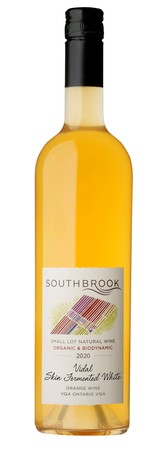Orange, Skin-contact Wines Secure Their Place
Wines with skin in the game.

Colour is important to wine. It’s the first quality that most people perceive, and we often anticipate a wine’s flavour and texture from its colour: we expect dark-red wines to be full-bodied and full of flavour and lighter-red wines to be lighter in body and more delicate in flavour—even though it doesn’t always work out that way. Colour is especially important for rosé wines because many consumers buy them by their colour, which ranges from the palest to the most-vivid pink. Because colour is so important, rosé bottles are almost always made of clear glass rather than the dark glass used to protect reds and many whites from light.
In recent years, another colour has been added to the red-white-rosé tricolour of wines: orange. Some wines are labelled Orange—VQA authorities in British Columbia and Ontario have added Orange as a category of wine—but others are simply some shade of orange, just as red, rosé, and white wines all come in varying shades and densities of colour. The hues of orange wines range from straw and amber to orange and copper. The wines are also bottled in clear glass so consumers can see what they’re buying.

Some orange wines are labelled not by their colour but by the winemaking process that produces them: “skin-contact” or “skin-fermented.” After the grapes have been crushed or pressed, the juice is left in contact with the grape skins (a practice known as maceration) for a period of time and during fermentation, rather than being drawn off the skins as it is to make white wine. Skin-contact is how red wine is made: the juice of almost all red wine grapes is clear, and the colour comes from contact with the skins, which contain colour (and tannins).
In the case of orange wines, keeping the juice in contact with the skins (that is, making them like red wine but with white grapes) gives the juice colour and other qualities that most white wines lack. Although most white wine grapes look green when they’re ripe, some have colour compounds in the yellow-orange range that are transferred to the juice and then the wine. The result is orange or skin-contact wines, which typically taste quite different from whites. The skins give them richer, more pungent flavours and more noticeable tannins, although they’re never as tannic as most red wines. Beyond that, they are conventional wines and should be judged the same way: on the quality of their components and on the way the components are balanced.
Orange wines are polarizing; they are the Marmite of wine—not to everyone’s taste and quite off-putting to some people. They are probably what is often called an acquired taste, and as for all food and drink in that category, people have to persist in consuming something they initially don’t like in order to acquire a liking for it. (Why people give up on Marmite immediately but persist in eating or drinking other things they don’t like at first is a mystery.)
Orange/skin-contact wines are a legitimate category, and they are becoming more and more common and popular, even though they don’t come close to reds, whites, and rosés. They have a long lineage, being made as a style in Georgia (the country) for thousands of years. Elsewhere, winemaking in the distant past is little understood, but it’s quite possible that white grapes crushed and pressed by foot spent some time on their skins and made orange-like wines. Today the length of skin contact is carefully calibrated to achieve the result a winemaker is looking for. These are interesting and often delicious wines, well worth seeking out.
Some orange/skin-contact wines to try
Dirty Laundry Au Naturel Gewürztraminer (Okanagan Valley, British Columbia)
Dominio de Punctum Pomelado Orange Wine (DO La Mancha, Spain)
Loveblock Orange Sauvignon Blanc (Marlborough, New Zealand)
Southbrook Vineyards Skin Fermented Vidal (Niagara Peninsula, Ontario)
Sperling Vineyards Natural Amber Pinot Gris (Okanagan Valley, British Columbia)
Tawse Growers Blend Skin Fermented Pinot Gris (Niagara Peninsula, Ontario)

